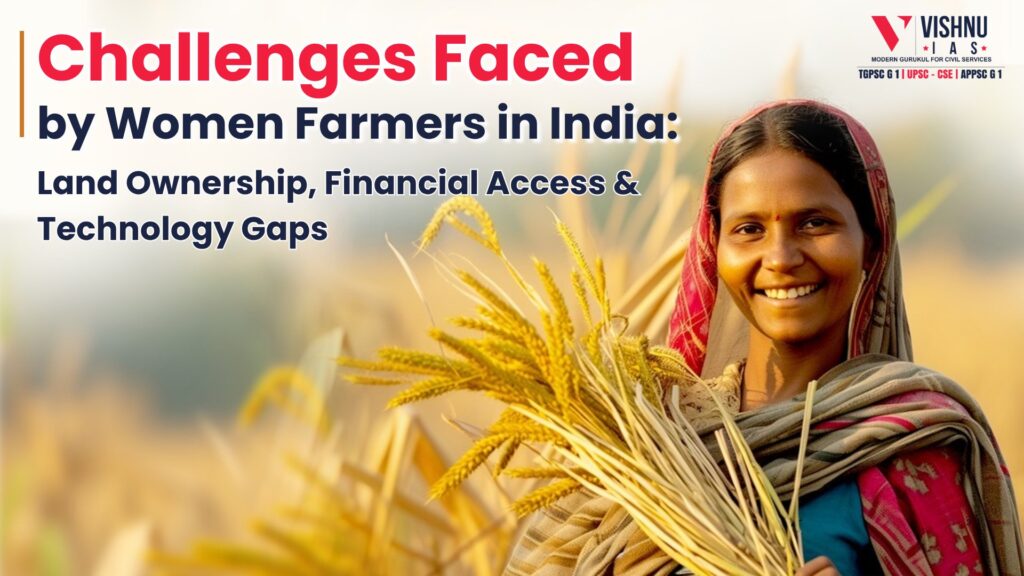Challenges Faced by Women Farmers in India: Land Ownership, Financial Access & Technology Gaps
Introduction
Women farmers in India play a pivotal role in the rural economy, contributing over 80% of the female workforce in rural areas (NSSO & Ministry of Agriculture, 2022). Despite their vital role, their contributions remain under-recognized and under-supported. According to the FAO, women produce 60–80% of food in developing countries, yet in India, only 14% of landholders are women (Agricultural Census 2015–16), and actual effective control is even lower (NFHS-5: only 8.3% women report land ownership).
With 2026 declared as the International Year of the Woman Farmer by the UN General Assembly, there's renewed attention on bridging systemic gaps in land ownership, financial inclusion, and technology access. This analysis examines these barriers through real-life examples and key policy frameworks.
1. Land Ownership: The Foundation of Agricultural Power
Legal and Institutional Barriers
- Patriarchal Inheritance Norms: Despite the Hindu Succession Act amendments (2005), rural families often follow patrilineal land transfers.
- Case Insight: A 2021 Landesa study in Uttar Pradesh and Odisha revealed only 13% of women had legal land documents, despite actively working the land.
- Titling Hurdles: Legal costs and lack of awareness deter women from registering land.
- Legal Literacy Gap: MAKAAM surveys show low awareness among women regarding inheritance rights.
Consequences of Low Land Ownership
- Credit Exclusion: Without land titles, women struggle to access Kisan Credit Cards (KCC) or crop loans.
- Farmer Status Denial: Landless women are often excluded from PM-KISAN and disaster relief.
- Marginal Decision-Making: Lack of land reduces influence in Panchayat agricultural planning.
Government Interventions & Limitations
2. Financial Access: From Marginal to Mainstream
Lack of Collateral and Credit History
- Collateral Barrier: Only 8.3% of women own land, making formal credit inaccessible.
- Dependence on Informal Credit: Women rely on moneylenders or Self-Help Groups (SHGs) for small, often insufficient loans.
- ENACT Insight: In Assam’s Nagaon district, women reported being pushed toward high-interest microfinance due to landless status.
Microfinance and Self-Help Groups
- Reach of SHGs: Over 6.9 crore women connected through NRLM’s SHGs (2024).
- Limitations: Typical loans range from Rs. 10,000–50,000—insufficient for major investments.
- Case Example: SEWA’s cooperative bank in Gujarat aided dairy enterprises but had limited scalability.
Promising Schemes and Gaps
- Stand-Up India Scheme: Provides Rs. 10 lakh–1 crore loans but low adoption in agriculture.
- PM-FME Scheme: Offers 40% subsidy to women-led units, yet faces awareness and documentation issues.
- Agriculture Infrastructure Fund (AIF): Women-led FPOs eligible, but only 13% of FPOs are currently women-led.
3. Technology Adoption: Enabling Smart Farming
Digital Divide and Mobile Access
- NFHS-5 Data: Only 54% of rural women own mobiles; just 22% access internet independently.
- Impact: Limits access to e-services, weather alerts, or mandi prices.
- ENACT Model: Weekly voice advisories reached 300+ women across 17 villages in Assam.
Knowledge Gaps in Machinery and Agri-tech
- Gendered Equipment Shortage: Most tools are designed for men, excluding women.
- Subsidy Access: Sub-Mission on Agricultural Mechanisation offers up to 80% subsidy—yet uptake is low.
- Digital Green Model: Uses local-language videos for skill transfer among women farmers.
Bridging the Technology Barrier
- KVKs’ Role: Need to ensure gender-sensitive training modules.
- PMGDISHA Program: Digital inclusion program needs targeted farming content for women.
- ENACT Centres: Use video conferencing for expert interactions—demonstrating a scalable solution.
Conclusion
Women farmers are the invisible backbone of Indian agriculture, yet they face structural exclusions from land rights, formal finance, and digital innovations. These limitations hinder not only their empowerment but also India’s agricultural productivity and food security goals.
As per the Global Gender Gap Report 2024, India ranks 127 out of 146 countries—economic participation being a major concern, strongly linked to women in agriculture.
Recognizing 2026 as the International Year of the Woman Farmer, India has a historic opportunity to lead global change in gender-just agriculture—in alignment with SDG 5 (Gender Equality) and SDG 2 (Zero Hunger).


